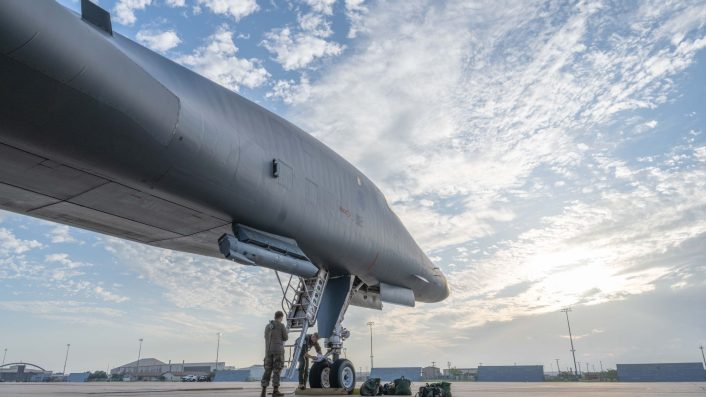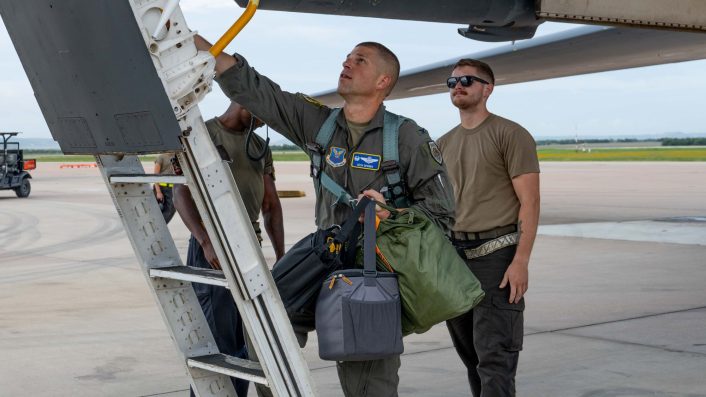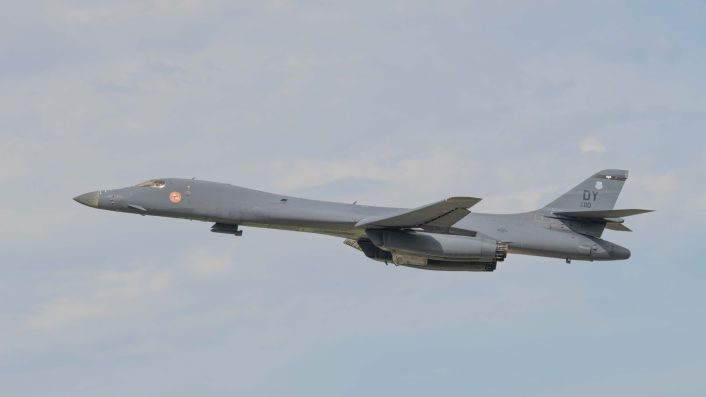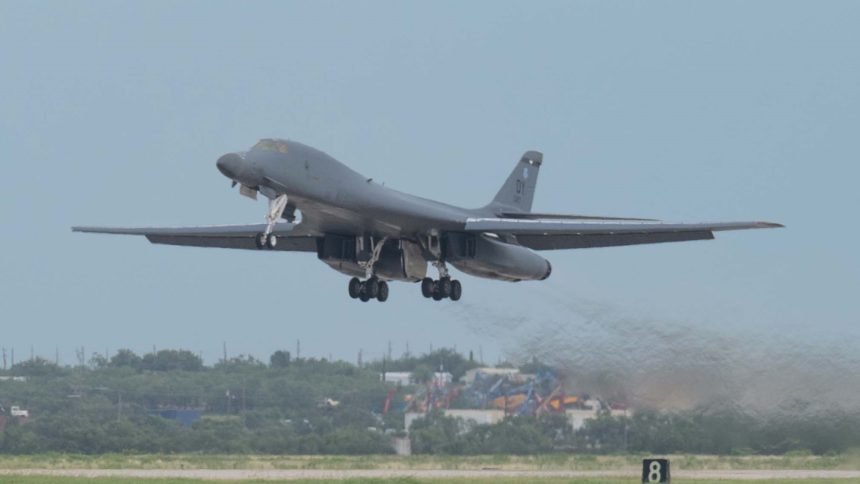By forward basing Mission Planning Cells at Nellis AFB, the 9th Bomb Squadron flew complex strike missions at the Nevada Test and Firing Range from Dyess AFB.
At its first participation in Red Flag in three years, B-1B Lancer bombers of the 9th Bomb Squadron (9th BS) “Bats” from Dyess AFB, Texas, flew daily round-trip sorties to the Nevada Test and Firing Range from Jul. 21 to Jul. 25, 2025. The unique “hybrid operations” model practiced during Red Flag Nellis 25-3 demonstrated the 9th BS and its parent 7th Bomb Wing’s (7th BW) Dynamic Force Employment (DFE) capability.
The defining feature of the drills was that Mission Planning Teams (MPCs) were located at Nellis AFB, Nevada, instead of the home base of Dyess AFB, complicating logistics and operations. Red Flag Nellis 25-3, held at Nellis AFB from Jul. 21 to 31, is the latest edition of the U.S. Air Force’s premier large-force combat training exercise, enhancing “integration and readiness across joint and allied forces in a contested environment.”
The drills created a realistic threat environment where the bombers would be exposed to enemy engagement while conducting sorties, a release from the 7th Bomb Wing (7th BW) said. In a model more representative of an actual Large Force Exercise within the broad gamut of a DFE, the B-1B crews also coordinated with units from other bases, with whom they would deploy during actual operations.
As The Aviationist has noted in previous reports about USAF A-10 Warthog and F-22 Raptor deployments in the Indo-Pacific theater, DFE involves remaining strategically unpredictable by suddenly deploying to other own or Allied bases, disrupting an adversary’s ability to respond quickly and coherently.

The exercise
According to the release, the “hybrid operations model” involved Dyess’ B-1Bs with “daily sorties flown from home station while mission planning cell teams operated forward from Nellis.” According to 9th BS commander Lt. Col. Ashley Cook, the latest Red Flag was a milestone not only because it was their first Red Flag in three years, but also because they launched combat power flexibly from Dyess while seamlessly integrating with joint and coalition forces launching from Nellis.
Dyess’ B-1Bs first conducted familiarization flights to the 12,000 square miles of airspace and 2.9 million acres of land of the Nevada Test and Firing Range, ahead of the main exercise window. These flights were then followed by daily mission profiles during “VULs” (vulnerability periods) in their hybrid operations model. While the bombers flew from their home station, the Mission Planning Cells (MPCa) operated from Nellis.
At one point, during one of the flights to the NTTR, the B-1Bs landed at Nellis AFB for a hot-pit refueling. “Midway through the exercise, B-1s landed at Nellis for hot-pit refueling and aircrew swaps, allowing a second MPC team to plan and execute the final phase of the exercise,” said the release.
This is similar to the U.S. Air Force’s ‘hub-and-spoke’ concept, which envisages units operating out of a main base, acting as a ‘hub’ (in this case Dyess AFB), while fanning out across either smaller airfields or other bases, acting as ‘spokes’ (in this case Nellis AFB). ‘Spokes’ could be within the theater’s operational area and inside the adversary’s A2/AD (Anti-Access/Area Denial) weapons umbrella. It must be noted that the release does not make any explicit reference to ‘hub-and-spoke.’

It is not clear if any live fire component was involved, and the images released do not show weapons being loaded into the B-1Bs’ internal bays. However, since streamlining and honing the logistical ends of strike missions has been a major focus of USAF exercises, it is likely Maintenance Squadrons and Munitions Airmen had a larger role to play in the preparations at Dyess AFB.
Hot-pit refueling is now a routine feature in USAF drills, often performed as part of Agile Combat Employment operations. Aircraft rapidly refuel without powering down their engines, reducing the turnaround time to get back into the air, while also reducing vulnerability to standoff strikes targeting aircraft on the ground.
The Total Force integration element was represented by B-1Bs from the 345th BS, Dyess AFB’s Air Force Reserve associate unit, also participating in the exercise.

VULs and detached Mission Planning Cells
“During Red Flag, Dyess aircrews flew daily VUL sorties from Texas to Nevada, executing simulated strike missions in a contested, high-threat environment,” the statement explained. “VUL periods refer to the most vulnerable phases of a mission, which are when aircraft are exposed to simulated enemy engagement or actively conducting strike operations.”
A B-1B Lancer departs Dyess AFB to participate in Red Flag 25-3. Any of the maintainers stand out!? #logo pic.twitter.com/F3KQ7KVhuL
— Saint1 (@Saint1Mil) August 4, 2025
“The ability to fly from home station while executing advanced planning with a dislocated MPC team shows how we’re evolving to meet future combat scenarios,” said Lt. Col. Cook. “Exercises like this prepare us to be more agile to practice how we would employ against today’s threats.”
Capt. Nicole Sorrells, a 9th BS flight commander, explained how relying on forward-based MPCs meant bomber crews and ground personnel had to take into account everything from mission briefs, takeoff times, airspace control, while executing VULs from Dyess AFB. “The hybrid model, with home-station sorties and remote MPC support, required precise mission timing and coordination between Dyess and Nellis,” the release added.
“The ability to fly from home station while executing advanced planning with a dislocated MPC team shows how we’re evolving to meet future combat scenarios,” said Cook. “Exercises like this prepare us to be more agile to practice how we would employ against today’s threats.”
“This is one of the first chances our new aviators get to experience a true Large Force Exercise,” further added Capt. Sorrells, explaining the importance of Red Flag. “It’s nothing like flying local sorties; we’re face-to-face with other squadrons and partners we’d deploy with. That’s where real integration happens.”
Artistic: even in the bright city lights, the afterburner stands out.
B-1 powering it up out of Nellis AFB, Nevada. 📷: NAFBpic.twitter.com/nBCgBRLsJ0
— Air Safety #OTD by Francisco Cunha (@OnDisasters) August 4, 2025
Red Flag 25-3 gave Dyess aviators the opportunity to fly both as ‘Blue Air’ and ‘Red Air’, alternating between friendly strike roles and simulated adversary missions, the release added. This suggests the B-1Bs may have played the role of Russian or Chinese bombers, conducting standoff air-launched cruise and ballistic missile strikes at Allied bases.









